-
Getting Started with NetScaler
-
Deploy a NetScaler VPX instance
-
Optimize NetScaler VPX performance on VMware ESX, Linux KVM, and Citrix Hypervisors
-
Apply NetScaler VPX configurations at the first boot of the NetScaler appliance in cloud
-
Configure simultaneous multithreading for NetScaler VPX on public clouds
-
Install a NetScaler VPX instance on Microsoft Hyper-V servers
-
Install a NetScaler VPX instance on Linux-KVM platform
-
Prerequisites for installing NetScaler VPX virtual appliances on Linux-KVM platform
-
Provisioning the NetScaler virtual appliance by using OpenStack
-
Provisioning the NetScaler virtual appliance by using the Virtual Machine Manager
-
Configuring NetScaler virtual appliances to use SR-IOV network interface
-
Configure a NetScaler VPX on KVM hypervisor to use Intel QAT for SSL acceleration in SR-IOV mode
-
Configuring NetScaler virtual appliances to use PCI Passthrough network interface
-
Provisioning the NetScaler virtual appliance by using the virsh Program
-
Provisioning the NetScaler virtual appliance with SR-IOV on OpenStack
-
Configuring a NetScaler VPX instance on KVM to use OVS DPDK-Based host interfaces
-
-
Deploy a NetScaler VPX instance on AWS
-
Deploy a VPX high-availability pair with elastic IP addresses across different AWS zones
-
Deploy a VPX high-availability pair with private IP addresses across different AWS zones
-
Protect AWS API Gateway using the NetScaler Web Application Firewall
-
Configure a NetScaler VPX instance to use SR-IOV network interface
-
Configure a NetScaler VPX instance to use Enhanced Networking with AWS ENA
-
Deploy a NetScaler VPX instance on Microsoft Azure
-
Network architecture for NetScaler VPX instances on Microsoft Azure
-
Configure multiple IP addresses for a NetScaler VPX standalone instance
-
Configure a high-availability setup with multiple IP addresses and NICs
-
Configure a high-availability setup with multiple IP addresses and NICs by using PowerShell commands
-
Deploy a NetScaler high-availability pair on Azure with ALB in the floating IP-disabled mode
-
Configure a NetScaler VPX instance to use Azure accelerated networking
-
Configure HA-INC nodes by using the NetScaler high availability template with Azure ILB
-
Configure a high-availability setup with Azure external and internal load balancers simultaneously
-
Install a NetScaler VPX instance on Azure VMware solution
-
Configure a NetScaler VPX standalone instance on Azure VMware solution
-
Configure a NetScaler VPX high availability setup on Azure VMware solution
-
Configure address pools (IIP) for a NetScaler Gateway appliance
-
Deploy a NetScaler VPX instance on Google Cloud Platform
-
Deploy a VPX high-availability pair on Google Cloud Platform
-
Deploy a VPX high-availability pair with external static IP address on Google Cloud Platform
-
Deploy a single NIC VPX high-availability pair with private IP address on Google Cloud Platform
-
Deploy a VPX high-availability pair with private IP addresses on Google Cloud Platform
-
Install a NetScaler VPX instance on Google Cloud VMware Engine
-
-
Solutions for Telecom Service Providers
-
Load Balance Control-Plane Traffic that is based on Diameter, SIP, and SMPP Protocols
-
Provide Subscriber Load Distribution Using GSLB Across Core-Networks of a Telecom Service Provider
-
Authentication, authorization, and auditing application traffic
-
Basic components of authentication, authorization, and auditing configuration
-
Web Application Firewall protection for VPN virtual servers and authentication virtual servers
-
On-premises NetScaler Gateway as an identity provider to Citrix Cloud
-
Authentication, authorization, and auditing configuration for commonly used protocols
-
Troubleshoot authentication and authorization related issues
-
-
-
-
-
-
Configure DNS resource records
-
Configure NetScaler as a non-validating security aware stub-resolver
-
Jumbo frames support for DNS to handle responses of large sizes
-
Caching of EDNS0 client subnet data when the NetScaler appliance is in proxy mode
-
Use case - configure the automatic DNSSEC key management feature
-
Use Case - configure the automatic DNSSEC key management on GSLB deployment
-
-
-
Persistence and persistent connections
-
Advanced load balancing settings
-
Gradually stepping up the load on a new service with virtual server–level slow start
-
Protect applications on protected servers against traffic surges
-
Retrieve location details from user IP address using geolocation database
-
Use source IP address of the client when connecting to the server
-
Use client source IP address for backend communication in a v4-v6 load balancing configuration
-
Set a limit on number of requests per connection to the server
-
Configure automatic state transition based on percentage health of bound services
-
-
Use case 2: Configure rule based persistence based on a name-value pair in a TCP byte stream
-
Use case 3: Configure load balancing in direct server return mode
-
Use case 6: Configure load balancing in DSR mode for IPv6 networks by using the TOS field
-
Use case 7: Configure load balancing in DSR mode by using IP Over IP
-
Use case 10: Load balancing of intrusion detection system servers
-
Use case 11: Isolating network traffic using listen policies
-
Use case 12: Configure Citrix Virtual Desktops for load balancing
-
Use case 13: Configure Citrix Virtual Apps and Desktops for load balancing
-
Use case 14: ShareFile wizard for load balancing Citrix ShareFile
-
Use case 15: Configure layer 4 load balancing on the NetScaler appliance
-
-
-
-
Authentication and authorization for System Users
-
-
Configuring a CloudBridge Connector Tunnel between two Datacenters
-
Configuring CloudBridge Connector between Datacenter and AWS Cloud
-
Configuring a CloudBridge Connector Tunnel Between a Datacenter and Azure Cloud
-
Configuring CloudBridge Connector Tunnel between Datacenter and SoftLayer Enterprise Cloud
-
Configuring a CloudBridge Connector Tunnel Between a NetScaler Appliance and Cisco IOS Device
-
CloudBridge Connector Tunnel Diagnostics and Troubleshooting
This content has been machine translated dynamically.
Dieser Inhalt ist eine maschinelle Übersetzung, die dynamisch erstellt wurde. (Haftungsausschluss)
Cet article a été traduit automatiquement de manière dynamique. (Clause de non responsabilité)
Este artículo lo ha traducido una máquina de forma dinámica. (Aviso legal)
此内容已经过机器动态翻译。 放弃
このコンテンツは動的に機械翻訳されています。免責事項
이 콘텐츠는 동적으로 기계 번역되었습니다. 책임 부인
Este texto foi traduzido automaticamente. (Aviso legal)
Questo contenuto è stato tradotto dinamicamente con traduzione automatica.(Esclusione di responsabilità))
This article has been machine translated.
Dieser Artikel wurde maschinell übersetzt. (Haftungsausschluss)
Ce article a été traduit automatiquement. (Clause de non responsabilité)
Este artículo ha sido traducido automáticamente. (Aviso legal)
この記事は機械翻訳されています.免責事項
이 기사는 기계 번역되었습니다.책임 부인
Este artigo foi traduzido automaticamente.(Aviso legal)
这篇文章已经过机器翻译.放弃
Questo articolo è stato tradotto automaticamente.(Esclusione di responsabilità))
Translation failed!
Install a NetScaler VPX instance on Azure VMware Solution
Azure VMware Solution (AVS) provides you with private clouds that contain vSphere clusters, built from dedicated bare-metal Azure infrastructure. The minimum initial deployment is three hosts, but additional hosts can be added one at a time, up to a maximum of 16 hosts per cluster. All provisioned private clouds have vCenter Server, vSAN, vSphere, and NSX-T.
The VMware Cloud (VMC) on Azure enables you to create cloud software-defined data centers (SDDC) on Azure with the number of ESX hosts that you want. The VMC on Azure supports NetScaler VPX deployments. VMC provides a user interface same as on-prem vCenter. It functions similar to the ESX-based NetScaler VPX deployments.
The following diagram shows the Azure VMware solution on the Azure public cloud that an administrator or a client can access over the internet. An administrator can create, manage, and configure workload or server VMs using Azure VMware solution. The admin can access the AVS’s web-based vCenter and NSX-T Manager from a Windows Jumpbox. You can create the NetScaler VPX instances (standalone or high availability pair) and server VMs within Azure VMware Solution using vCenter, and manage the corresponding networking using NSX-T manager. The NetScaler VPX instance on AVS works similar to the on-prem VMware cluster of hosts. AVS is managed from a Windows Jumpbox that is created in the same virtual network.
A client can only access the AVS service by connecting to the VIP of ADC. Another NetScaler VPX instance outside Azure VMware Solution but in the same Azure virtual network helps add the VIP of the NetScaler VPX instance within Azure VMware Solution as a service. As per requirement, you can configure the NetScaler VPX instance to provide service over the internet.

Prerequisites
Before you begin installing a virtual appliance, do the following:
- For more information on Azure VMware solution and its prerequisites, see Azure VMware Solution documentation.
- For more information on deploying Azure VMware solution, see Deploy an Azure VMware Solution private cloud.
- For more information on creating a Windows Jump box VM to access and manage Azure VMware Solution, see Access an Azure VMware Solution private cloud
- In Windows Jump box VM, download the NetScaler VPX appliance setup files.
- Create appropriate NSX-T network segments on VMware SDDC to which the virtual machines connect. For more information, see Add a network segment in Azure VMware Solution
- Obtain VPX license files.
- Virtual machines (VMs) created or migrated to the Azure VMware Solution private cloud must be attached to a network segment.
VMware cloud hardware requirements
The following table lists the virtual computing resources that the VMware SDDC must provide for each VPX nCore virtual appliance.
Table 1. Minimum virtual computing resources required for running a NetScaler VPX instance
| Component | Requirement |
|---|---|
| Memory | 2 GB |
| Virtual CPU (vCPU) | 2 |
| Virtual network interfaces | In VMware SDDC, you can install a maximum of 10 virtual network interfaces if the VPX hardware is upgraded to version 7 or higher. |
| Disk space | 20 GB |
Note
This is in addition to any disk requirements for the hypervisor.
For production use of the VPX virtual appliance, the full memory allocation must be reserved.
OVF Tool 1.0 system requirements
OVF Tool is a client application that can run on Windows and Linux systems. The following table describes the system requirements for installing OVF tool.
Table 2. System requirements for OVF tool installation
| Component | Requirement |
|---|---|
| Operating system | For detailed requirements from VMware, search for the “OVF Tool User Guide” PDF file at http://kb.vmware.com/. |
| CPU | 750 MHz minimum, 1 GHz or faster recommended |
| RAM | 1 GB Minimum, 2 GB recommended |
| NIC | 100 Mbps or faster NIC |
For information about installing OVF, search for the “OVF Tool User Guide” PDF file at http://kb.vmware.com/.
Downloading the NetScaler VPX setup files
The NetScaler VPX instance setup package for VMware ESX follows the Open Virtual Machine (OVF) format standard. You can download the files from the Citrix website. You need a Citrix account to log on. If you do not have a Citrix account, access the home page at http://www.citrix.com. Click the New Users link, and follow the instructions to create a new Citrix account.
Once logged on, navigate the following path from the Citrix home page:
Citrix.com > Downloads > NetScaler > Virtual Appliances.
Copy the following files to a workstation on the same network as the ESX server. Copy all three files into the same folder.
- NSVPX-ESX-<release number>-<build number>-disk1.vmdk (for example, NSVPX-ESX-13.0-79.64-disk1.vmdk)
- NSVPX-ESX-<release number>-<build number>.ovf (for example, NSVPX-ESX-13.0-79.64.ovf)
- NSVPX-ESX-<release number>-<build number>.mf (for example, NSVPX-ESX-13.0-79.64.mf)
Deploy Azure VMware solution
- Log in to your Microsoft Azure portal, and navigate to Azure Marketplace.
-
From the Azure Marketplace, search Azure VMware Solution and click Create.
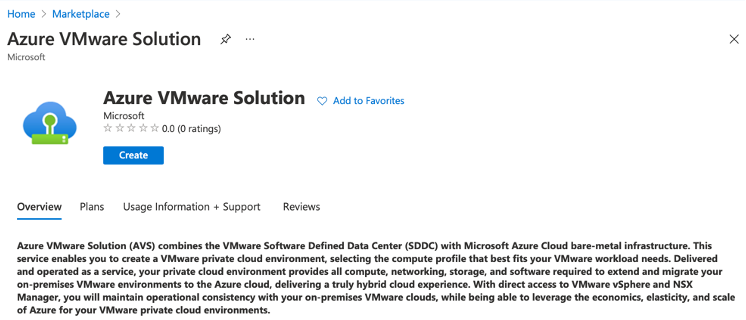
-
In the Create a private cloud page, enter the following details:
- Select a minimum of 3 ESXi hosts to create the default cluster of your private cloud.
- For the Address block field, use /22 address space.
- For the Virtual Network, make sure that the CIDR range doesn’t overlap with any of your on-premises or other Azure subnets (virtual networks) or with the gateway subnet.
- Gateway subnet is used to express route the connection with private cloud.
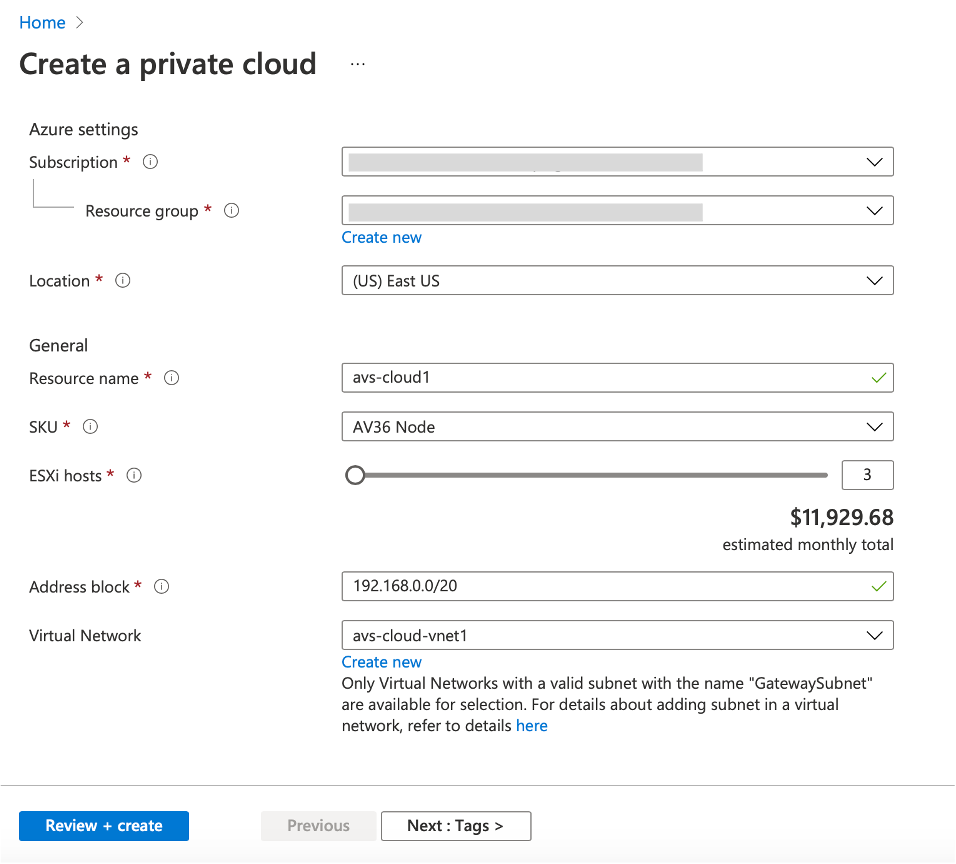
- Click Review + Create.
-
Review the settings. If you must change any settings, click Previous.
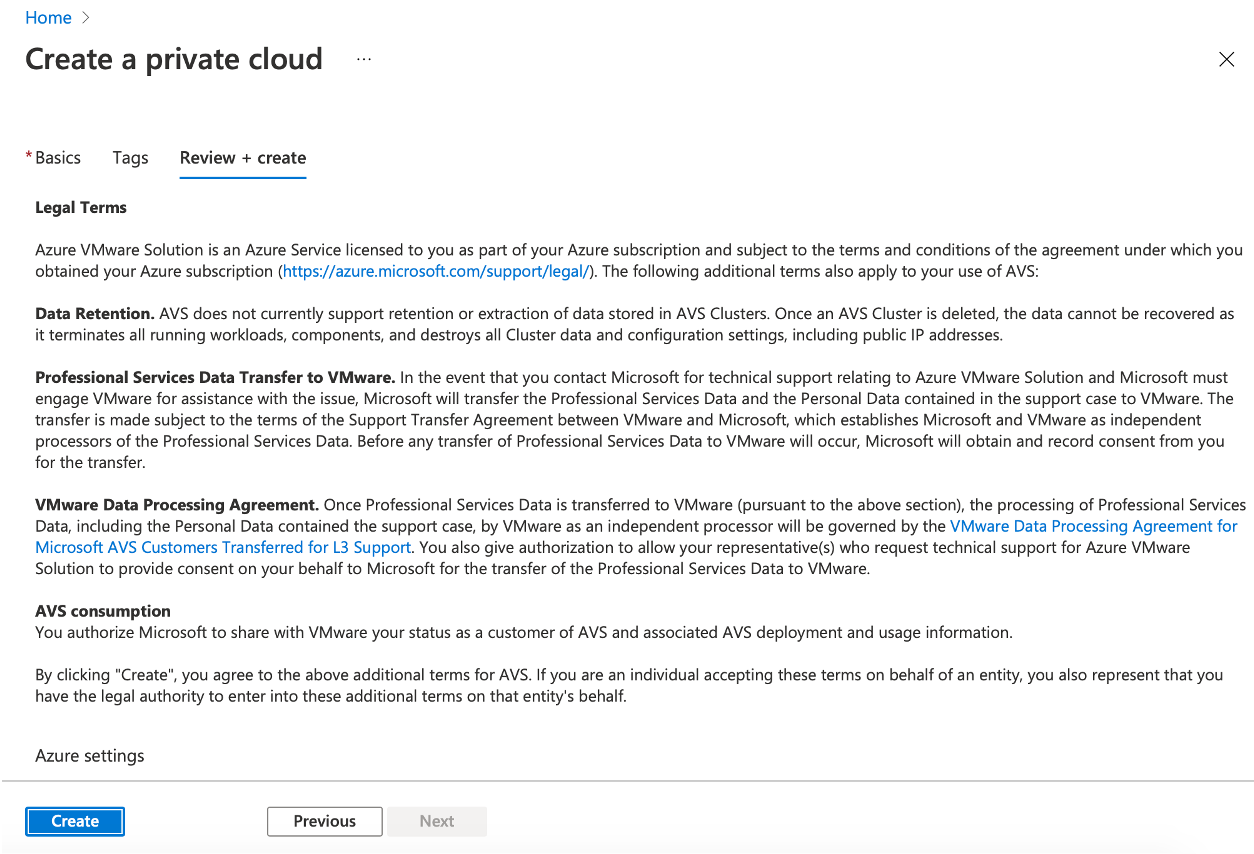
-
Click Create. Private cloud provisioning process starts. It can take up to two hours for the private cloud to be provisioned.
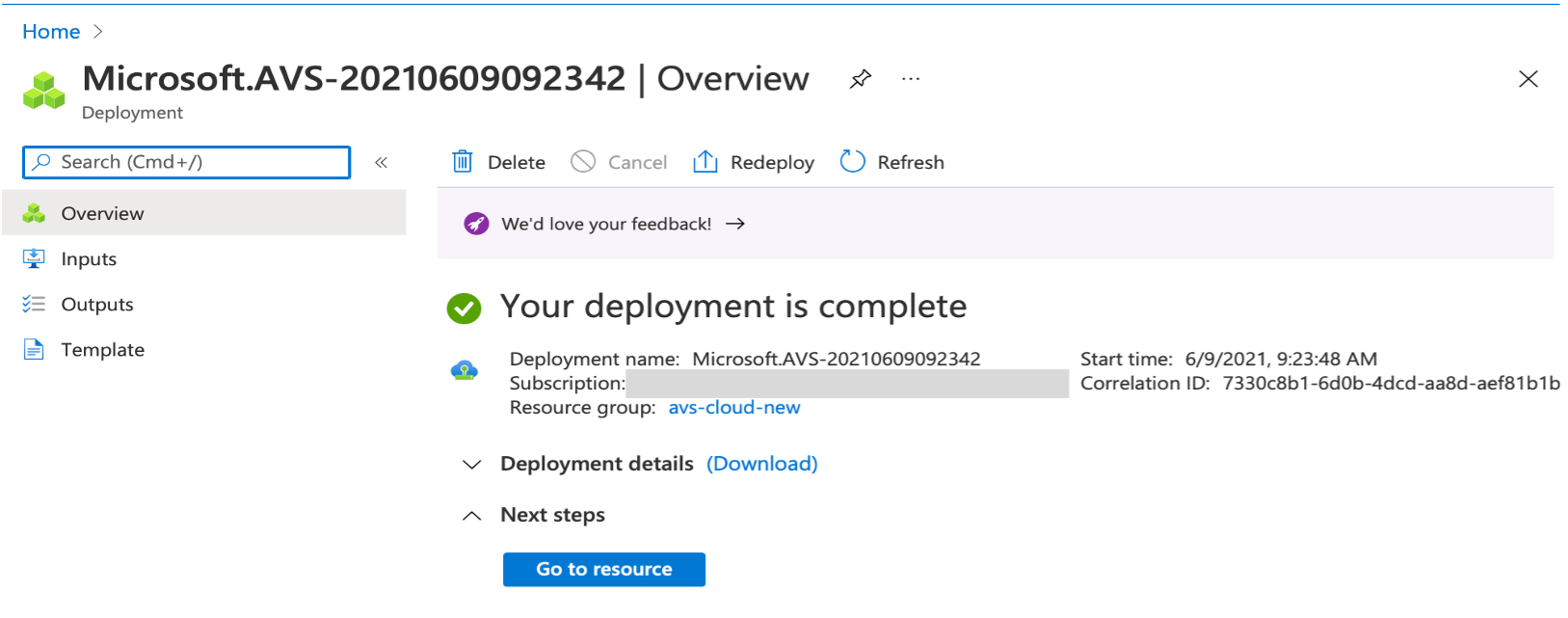
-
Click Go to resource, to verify the private cloud that is created.
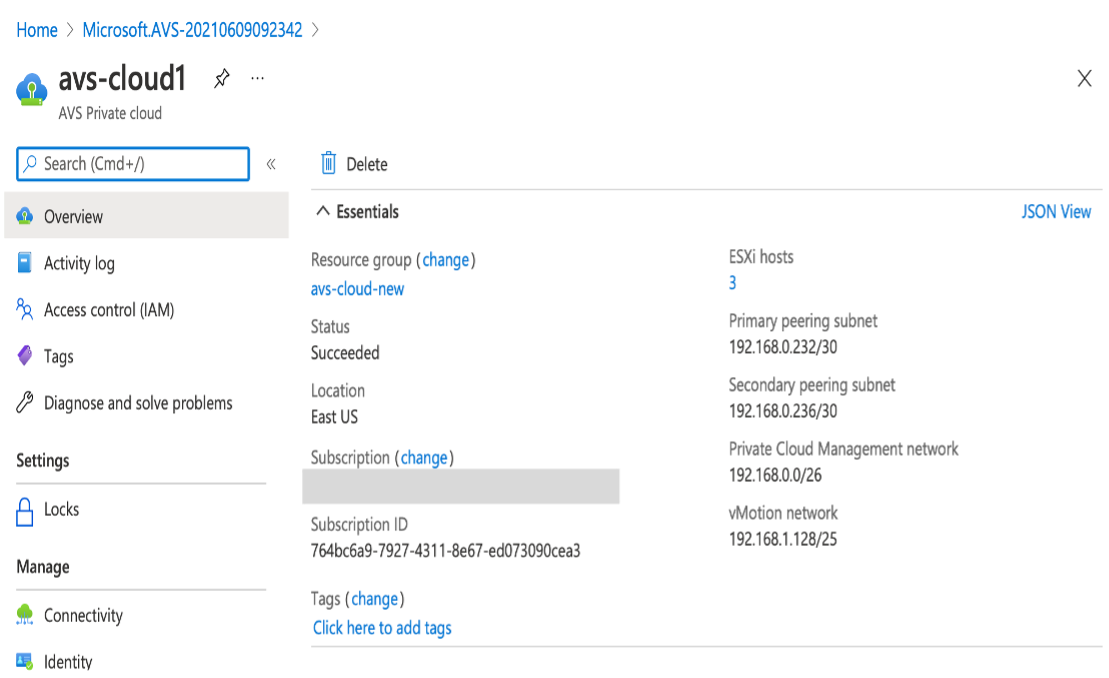
Note
To access this resource, you need a VM in Windows that acts as a Jump box.
Connect to an Azure virtual machine running Windows
This procedure shows you how to use the Azure portal to deploy a virtual machine (VM) in Azure that runs Windows Server 2019. To see your VM in action, you then RDP to the VM and install the IIS web server.
To access the private cloud that you have created, you need to create a Windows Jump box within the same virtual network.
-
Go to the Azure portal, and click Create a Resource.

-
Search for Microsoft Windows 10, and click Create.
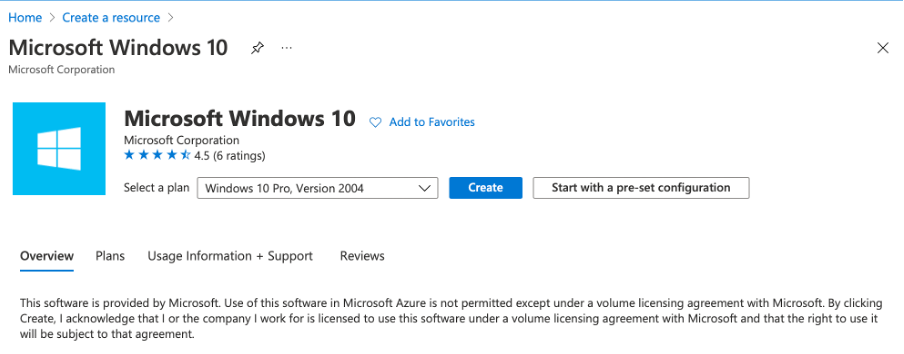
-
Create a virtual machine (VM) that runs Windows Server 2019. The Create a virtual machine page appears. Enter all the details in Basics tab, and select the Licensing check box. Leave the remaining defaults and then select the Review + create button at the bottom of the page.
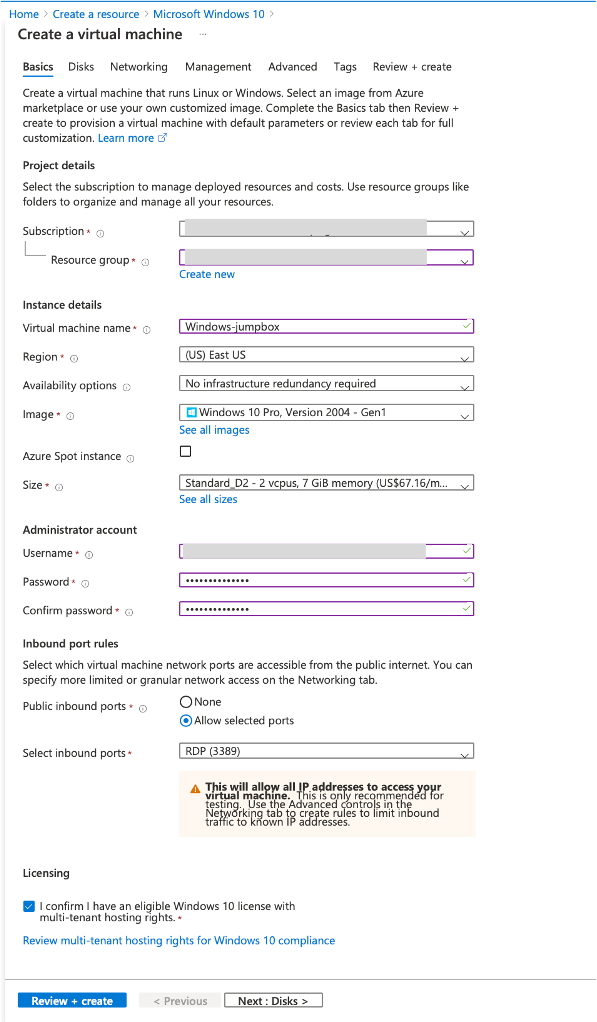
- After validation runs, select the Create button at the bottom of the page.
- After the deployment is complete, select Go to resource.
-
Go to the Windows VM that you have created. Use the public IP address of the Windows VM and connect using RDP.
Use the Connect button in the Azure portal to start a Remote Desktop (RDP) session from a Windows desktop. First you connect to the virtual machine, and then you sign on.
To connect to a Windows VM from a Mac, you must install an RDP client for Mac such as Microsoft Remote Desktop. For more information, see How to connect and sign on to an Azure virtual machine running Windows.
Access your Private Cloud vCenter portal
-
In your Azure VMware Solution private cloud, under Manage, select Identity. Make note of the vCenter credentials.
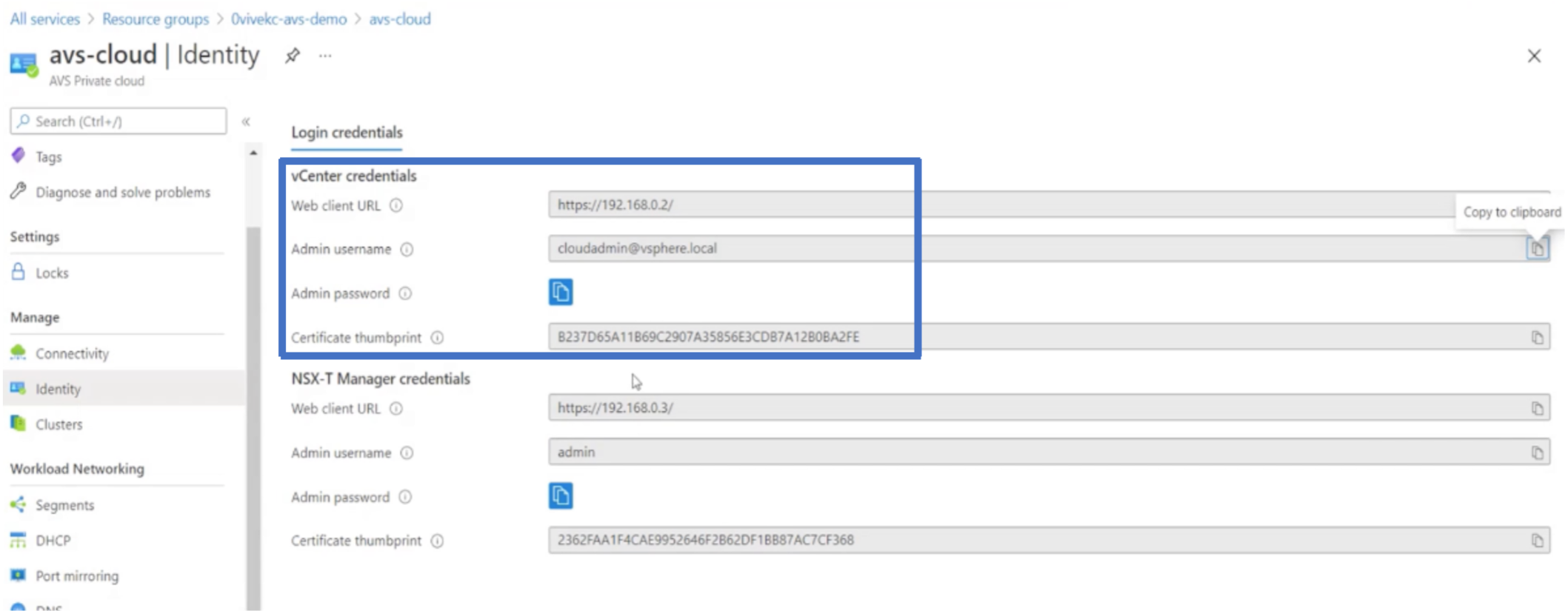
-
Launch the vSphere client by typing the vCenter web client URL.

-
Log in to VMware vSphere using the vCenter credentials of your Azure VMware Solution private cloud.
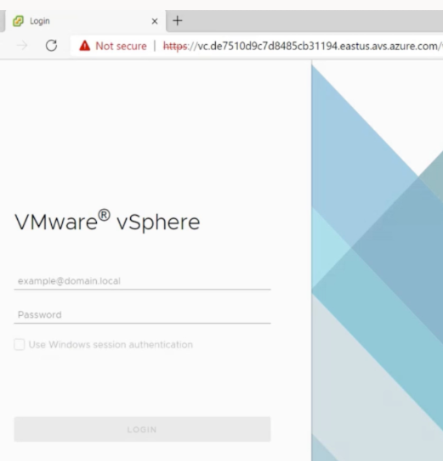
-
In the vSphere client, you can verify the ESXi hosts that you created in Azure portal.
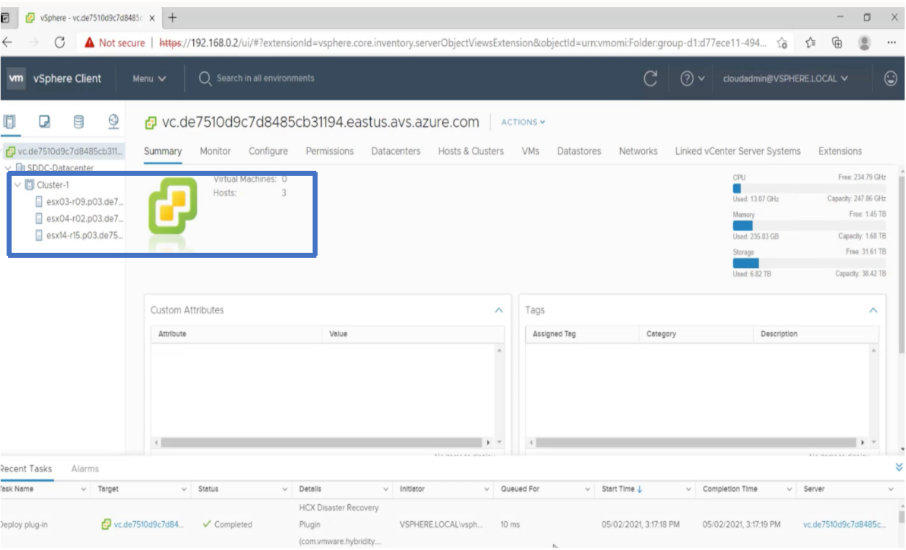
For more information, see Access your Private Cloud vCenter portal.
Create an NSX-T segment in the Azure portal
You can create and configure an NSX-T segment from the Azure VMware Solution console in the Azure portal. These segments are connected to the default Tier-1 gateway, and the workloads on these segments get East-West and North-South connectivity. Once you create the segment, it displays in NSX-T Manager and vCenter.
-
In your Azure VMware Solution private cloud, under Workload Networking, select Segments > Add. Provide the details for the new logical segment and select OK. You can create three separate segments for Client, Management, and Server interfaces.

-
In your Azure VMware Solution private cloud, under Manage, select Identity. Make note of the NSX-T Manager credentials.

-
Launch the VMware NSX-T Manager by typing the NSX-T web client URL.

-
In the NSX-T manager, under Networking > Segments, you can see all the segments that you have created. You can also verify the subnets.
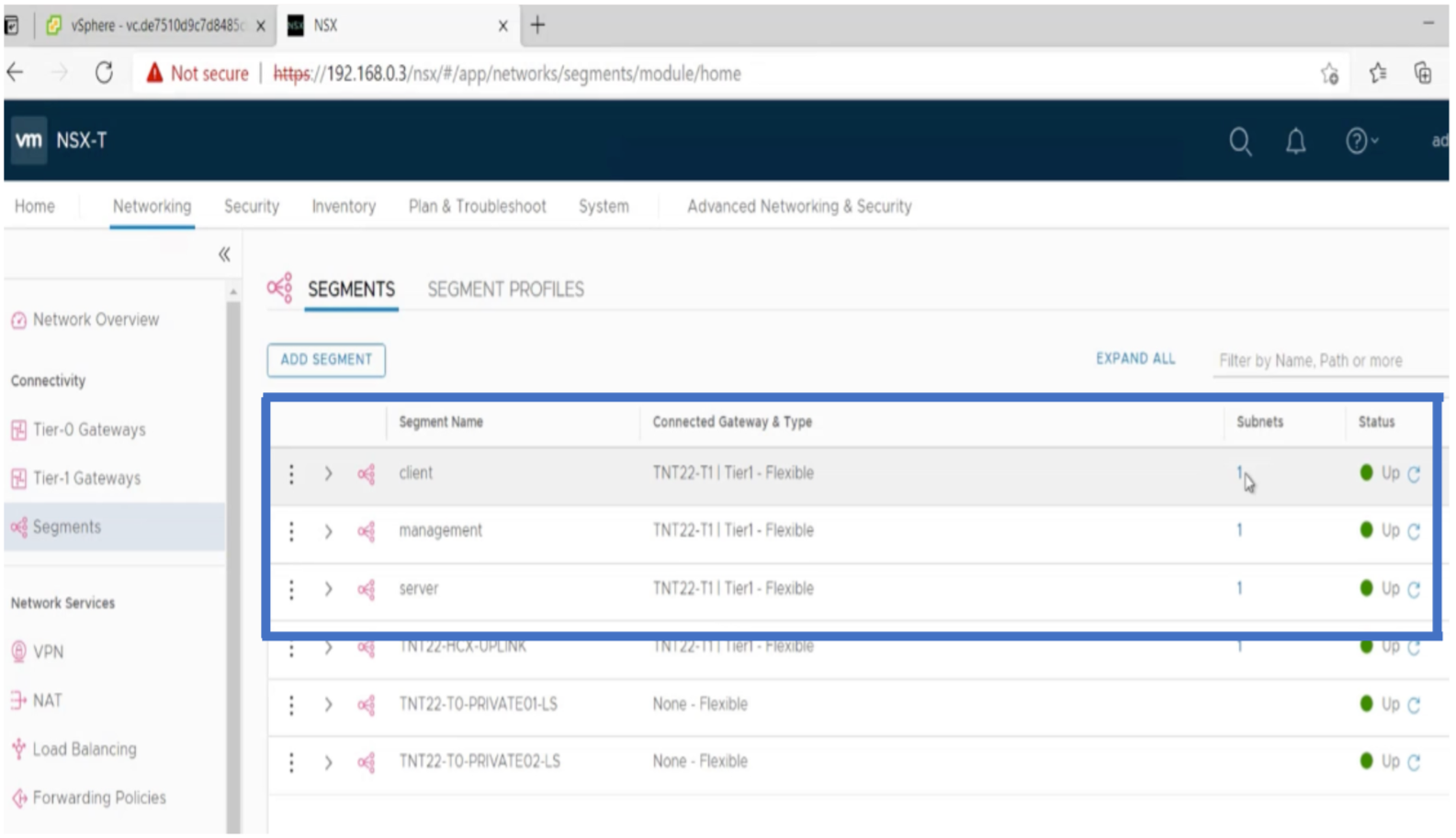
For more information, see Create an NSX-T segment in the Azure portal.
Install a NetScaler VPX instance on VMware cloud
After you have installed and configured VMware Software-Defined Data Center (SDDC), you can use the SDDC to install virtual appliances on the VMware cloud. The number of virtual appliances that you can install depends on the amount of memory available on the SDDC.
To install NetScaler VPX instances on VMware cloud, perform these steps in Windows Jumpbox VM:
- Download the NetScaler VPX instance setup files for ESXi host from the NetScaler downloads site.
- Open VMware SDDC in the Windows Jumpbox.
- In the User Name and Password fields, type the administrator credentials, and then click Login.
- On the File menu, click Deploy OVF Template.
-
In the Deploy OVF Template dialog box, in Deploy from file field, browse to the location at which you saved the NetScaler VPX instance setup files, select the .ovf file, and click Next.
Note:
By default, the NetScaler VPX instance uses E1000 network interfaces. To deploy ADC with the VMXNET3 interface, modify the OVF to use VMXNET3 interface instead of E1000. Availability of VMXNET3 interface is limited by Azure infrastructure and might not be available in Azure VMware Solution.
-
Map the networks shown in the virtual appliance OVF template to the networks that you configured on the VMware SDDC. Click OK.
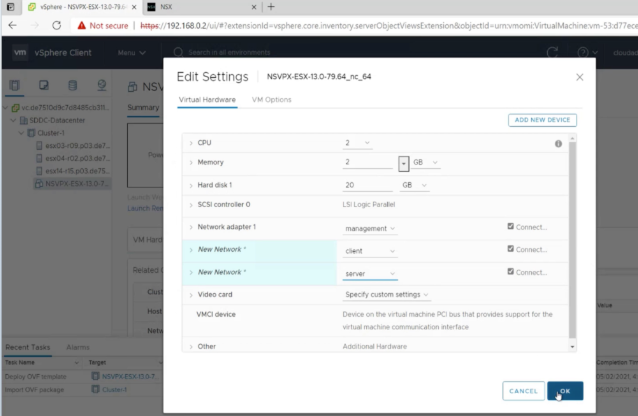
-
Click Finish to start installing a virtual appliance on VMware SDDC.

-
You are now ready to start the NetScaler VPX instance. In the navigation pane, select the NetScaler VPX instance that you have installed and, from the right-click menu, select Power On. Click the Console tab to emulate a console port.
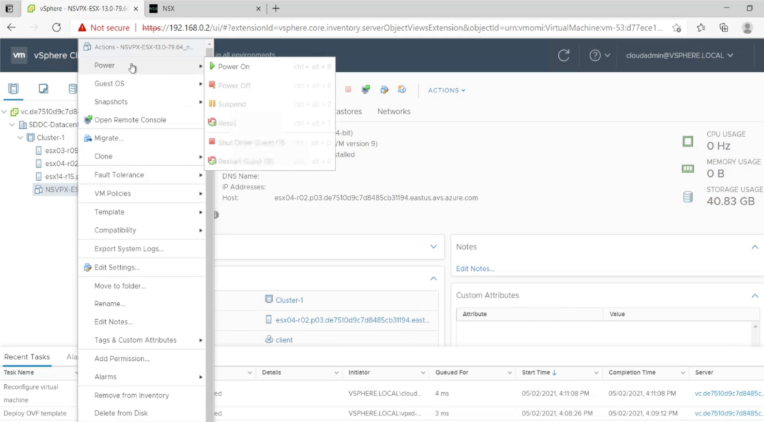
-
You are now connected to the NetScaler VM from the vSphere client.
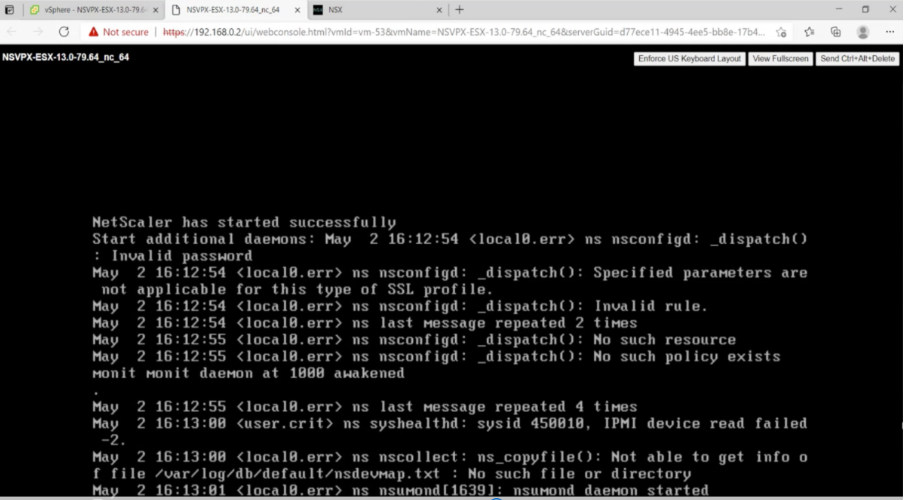
-
To access the NetScaler appliance by using the SSH keys, type the following command in the CLI:
ssh nsroot@<management IP address> <!--NeedCopy-->Example:
ssh nsroot@192.168.4.5 <!--NeedCopy--> -
You can verify the ADC configuration by using the
show ns ipcommand.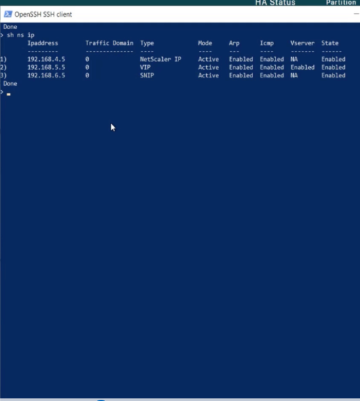
Share
Share
In this article
- Prerequisites
- VMware cloud hardware requirements
- OVF Tool 1.0 system requirements
- Downloading the NetScaler VPX setup files
- Deploy Azure VMware solution
- Connect to an Azure virtual machine running Windows
- Access your Private Cloud vCenter portal
- Create an NSX-T segment in the Azure portal
- Install a NetScaler VPX instance on VMware cloud
This Preview product documentation is Cloud Software Group Confidential.
You agree to hold this documentation confidential pursuant to the terms of your Cloud Software Group Beta/Tech Preview Agreement.
The development, release and timing of any features or functionality described in the Preview documentation remains at our sole discretion and are subject to change without notice or consultation.
The documentation is for informational purposes only and is not a commitment, promise or legal obligation to deliver any material, code or functionality and should not be relied upon in making Cloud Software Group product purchase decisions.
If you do not agree, select I DO NOT AGREE to exit.